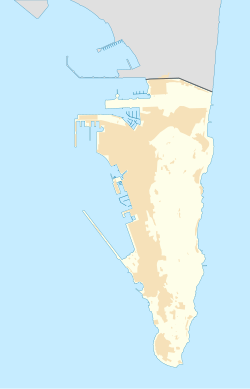| Devil's Tower | |
|---|---|
Torre del Diablo | |
| Part of Fortifications of Gibraltar | |
| Devil's Tower Road, Gibraltar | |
 1727 plan of Devil's Tower and Mill Tower. | |
| Site information | |
| Type | Watchtower |
| Condition | Demolished |
| Location | |
Original location of Devil's Tower within Gibraltar. | |
| Coordinates | 36°08′46″N5°20′30″W / 36.146143°N 5.341701°W |
| Site history | |
| Demolished | 1940 |
The Devil's Tower was an ancient watchtower in the British Overseas Territory of Gibraltar close to a rock shelter where fossil remains of a Neanderthal child were discovered, together with palaeolithic tools. The Tower and remains, however, were unrelated.

